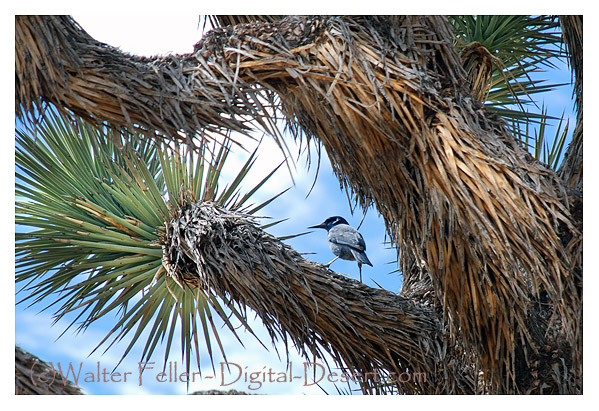Pinyon Jay
Gymnorhinus cyanocephalus
Pinyon jay rests in Joshua tree
Family: Corvidae Order: Passeriformes Class: Aves
DISTRIBUTION, ABUNDANCE, AND SEASONALITY
A fairly common but somewhat local, yearlong resident in coniferous habitats east of the
Cascade-Sierra Nevada crest from the Oregon border south to vicinity of Walker Pass, Kern
Co. Also found in most major desert mountain ranges, including the arid slopes of ranges
west of the deserts, from the White Mts. south to the San Jacinto Mts. and west to the Piute
Mts. (Kern Co.) and to Mt. Piņos. Preferred nesting habitats are
pinyon-juniper
(juniper
may be absent) and eastside pine. Breeders often range into sagebrush, bitterbrush and
grassland habitats to forage. Occasionally wanders to cismontane California, even to coast, in flocks in fall and
winter.
SPECIFIC HABITAT REQUIREMENTS
Feeding:
Omnivorous;
feeds on pine seeds, juniper berries, other seeds and fruits,
beetles, grasshoppers, caterpillars, ants, many other
invertebrates, and rarely
lizards.
Nesters appear to require pinyon, ponderosa, or Jeffrey pine seeds, which often are cached
in soil or crevices in bark near breeding areas. Hammers, pries, and pecks to extract seeds
from cones. Gleans foliage and probes bark and crevices for
insects, probes in soil for seeds
and insects, hunts for insects on ground, and sometimes hawks flying insects.
Cover: Trees of moderate size, especially
pinyon
and
juniper,
afford nesting, roosting, and
other cover.
Reproduction: Builds bulky, open-cup nest of twigs, bark shreds, grasses, other plant
fibers, wool, hair. Usually placed in pinyon or juniper at height of 0.9-6.2 m (3-20 ft), rarely to
25 m (80 ft), in ponderosa or Jeffrey pine.
Water: No additional information found. Eats snow in winter.
Pattern: Nesters most numerous in pinyon, ponderosa, and Jeffrey pine
woodlands
with
sparse to open canopy, and a well-defined
understory
of sagebrush, bitterbrush, and other shrubs.
SPECIES LIFE HISTORY
Activity Patterns: Yearlong, diurnal
activity.
Seasonal Movements/Migration: Usually resident yearlong, but unpredictable desertion of
nesting area occurs sporadically, probably when pine seeds are scarce. At such times, may
occur on both slopes of the Cascade-Sierra cordillera, rarely wandering westward to the coast
or southward into the mountains and coastal plains of southern California.
Home Range: In New Mexico, a flock ranged over 29 km˛ (11.2 mi˛) (Ligon 1971). In
Arizona, a flock ranged over 21 km˛ (8 mi˛).
Territory: Includes only nest and eggs.
Reproduction: May breed anytime from February through October if conditions are
propitious, but height of egg-laying probably April through June. Colonial nester with up to
3 nests recorded in 1 tree. As many as 54
nests have been found in a 50 ha (124 ac) area, a density of 1 nest per 0.9 ha (2.3 ac).
Monogamous; clutch averages 4-5 eggs (range 3-6). Single-brooded;
incubation 16-17 days, by female. Both parents
care for altricial young, occasionally assisted by other individuals. Fledging age
20-22 days.
Niche: Potential predators include mammals, owls, hawks, loggerhead shrikes. Many unrecovered pine seed caches germinate.
Comments: Highly gregarious at all seasons. Flocks of up to 400 have been observed in the Providence Mts.